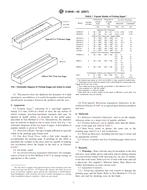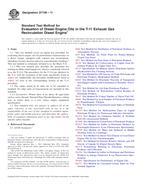1.1 This practice defines a set of terms, procedures, and data elements required to develop a national spatial dataset of features associated with excess spoil and refuse materials produced by coal mining operations. These features include excess spoil structures, coal preparation plants, and coal refuse structures.
1.1.1 Excess Spoil Structures – are created when the total spoil produced during mining exceeds the volume of material that can be utilized for reclamation. This occurrence is common in steep slope areas, where the final grade of reclaimed slopes is limited by stability requirements. It also occurs where overburden volume is significantly larger than the volume of minable coal. Spoil also exhibits a net increase in volume due to the introduction of void spaces in fragmented rock when overburden is removed to expose underlying coal seams. The production of excess spoil requires the creation of disposal structures that extend outside the mined area. These structures usually take the form of out-of-pit spoil piles, side-hill fills, or valley fills (See Fig. 1).
1.1.2 Coal Preparation Plants – are facilities where coal is separated from non-combustible materials, and potentially crushed, resized, and blended with other grades of coal. Preparation plants produce refuse as a byproduct.
1.1.3 Refuse – is a waste byproduct of coal processing, generally categorized as either coarse or fine. Fine coal refuse often is handled as a slurry containing a blend of water, fine coal, silt, sand, and clay particles.
1.1.4 Impounding Refuse Structures – create a holding area for slurry that allows solids to settle out and water to be recovered. Cross-valley and diked impoundments utilize an embankment, often constructed of coarse coal refuse, which forms a basin for slurry retention, as shown in Fig. 2 and Fig. 3 respectively. Incised impoundments dispose of slurry in an excavated area below the natural surface and do not utilize a significant embankment for slurry retention (See Fig. 4).
1.1.5 Non-Impounding Refuse Structures – may contain slurry that has been dewatered and stabilized prior to disposal. Non-impounding structures also may utilize slurry cells to dispose of fine refuse. Methods that significantly reduce the water content of fine coal refuse may allow a refuse structure to avoid being classified as an impoundment.
1.2 This practice addresses coal mining geospatial data relative to the Surface Mining Control and Reclamation Act of 1977 (SMCRA). SMCRA authorizes state and tribal Regulatory Authorities (RAs) to regulate surface coal mining operations (SCMO). Each RA shall be the authoritative data source (ADS) for coal mining geospatial data associated with its area of responsibility.
1.3 This standard is one of several that have been approved or are in development related to SMCRA approved coal mining operations. Also under development is a terminology standard. Initial development of these standards is being done on an individual basis; however, they may be consolidated to reduce repetition of information between them.
1.4 The values stated in either SI units or inch-pound units are to be regarded separately as standard. The values stated in each system may not be exact equivalents; therefore, each system shall be used independently of the other. Combining values from the two systems may result in non-conformance with the standard.
1.5 This standard does not purport to address all of the safety concerns, if any, associated with its use. It is the responsibility of the user of this standard to establish appropriate safety and health practices and determine the applicability of regulator limitations prior to use.
1.6 This practice offers a set of instructions for performing one or more specific operations. This document cannot replace education or experience and should be used in conjunction with professional judgment. Not all aspects of this practice may be applicable in all circumstances. This ASTM standard is not intended to represent or replace the standard of care by which the adequacy of a given professional service must be judged, nor should this document be applied without consideration of a project's many unique aspects. The word “Standard“ in the title of this document means only that the document has been approved through the ASTM consensus process.
Product Details
- Published:
- 05/15/2010
- Number of Pages:
- 10
- File Size:
- 1 file , 260 KB


